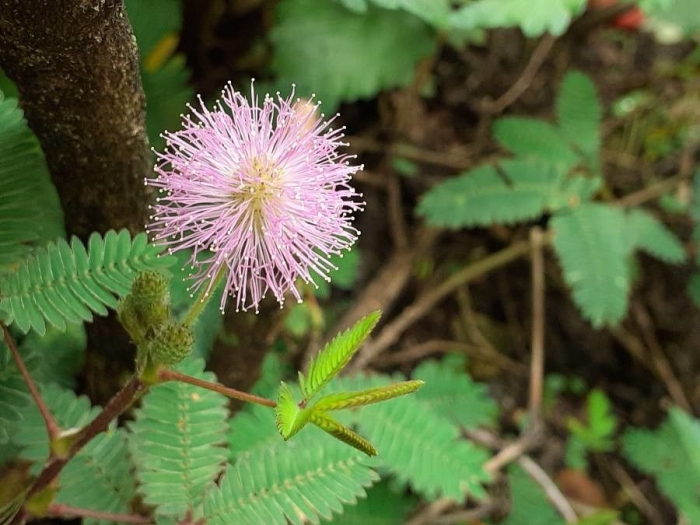Shameplant
(Mimosa pudica)
Shameplant (Mimosa pudica)
/
/

Ariel Aguirre
CC BY-SA 4.0
Image By:
Ariel Aguirre
Recorded By:
Copyright:
CC BY-SA 4.0
Copyright Notice:
Photo by: Ariel Aguirre | License Type: CC BY-SA 4.0 | License URL: https://creativecommons.org/licenses/by-sa/4.0/ | Attribution: Ariel Aguirre (cc-by-sa) | Rights Holder: Ariel Aguirre | Publisher: PlantNet | Date Created: 2020-03-15T11:49:39Z | Title: Mimosa pudica L.: flower | Notes: |





















































Estimated Native Range
Summary
Mimosa pudica, commonly known as the Shameplant, is a perennial herb native to Central and South America, thriving in a variety of habitats including open woodlands, grasslands, and disturbed areas. It typically grows to a height of 1-3 feet and a width of 3 feet. The plant is notable for its compound leaves that fold inward when touched and re-open within minutes, an adaptation thought to deter herbivores. The stems are erect in young plants but become creeping or trailing with age. From mid-summer, pale pink or purple flower heads emerge from the leaf axils, becoming more abundant as the plant matures. The flowers are globular and fluffy, adding to the plant’s ornamental appeal.
The Shameplant is valued for its rapid growth and fascinating leaf movement, making it a popular curiosity in gardens and as an educational plant. It is often used as ground cover or grown as an indoor plant in temperate regions. While it prefers nutrient-poor soil with good drainage, it is adaptable to various soil types. Mimosa pudica requires full sun and is frost-sensitive, necessitating protection in areas where temperatures fall below 13 °C (55 °F). It is propagated mainly by seed and requires medium amounts of water. However, gardeners should be cautious as it can become invasive outside its native range, particularly in Asia, Central America, the Caribbean, and parts of the United States.CC BY-SA 4.0
The Shameplant is valued for its rapid growth and fascinating leaf movement, making it a popular curiosity in gardens and as an educational plant. It is often used as ground cover or grown as an indoor plant in temperate regions. While it prefers nutrient-poor soil with good drainage, it is adaptable to various soil types. Mimosa pudica requires full sun and is frost-sensitive, necessitating protection in areas where temperatures fall below 13 °C (55 °F). It is propagated mainly by seed and requires medium amounts of water. However, gardeners should be cautious as it can become invasive outside its native range, particularly in Asia, Central America, the Caribbean, and parts of the United States.CC BY-SA 4.0
Plant Description
- Plant Type: Herb
- Height: 1-3 feet
- Width: 1-3 feet
- Growth Rate: Rapid
- Flower Color: Pink
- Flowering Season: Summer
- Leaf Retention: Deciduous
Growth Requirements
- Sun: Full Sun, Part Shade
- Water: Medium
- Drainage: Medium
Common Uses
Bee Garden, Bird Garden, Butterfly Garden, Drought Tolerant, Hummingbird Garden, Low Maintenance, Showy Flowers
Natural Habitat
Native to a variety of habitats including open woodlands, grasslands, and disturbed areas
Other Names
Common Names: Sleepy Plant, Action Plant, Sensitive-Plant, Sensitive-Weed, Touch-Me-Not, Common Sensitive-Plant, Sensitive, Sensitive Grass, Sensitive Plant, Shame Bush
Scientific Names: , Mimosa pudica, Mimosa pudica f. hispidior, Eburnax pudica,
GBIF Accepted Name: Mimosa pudica L.